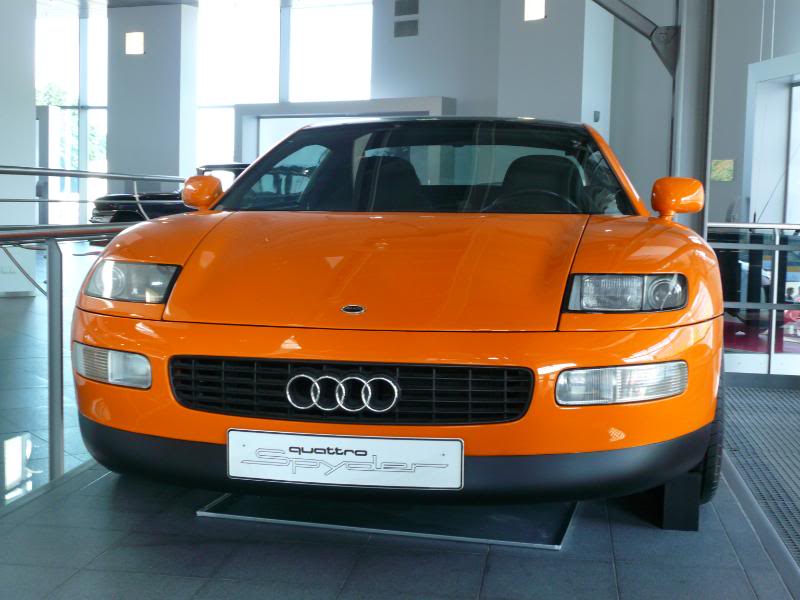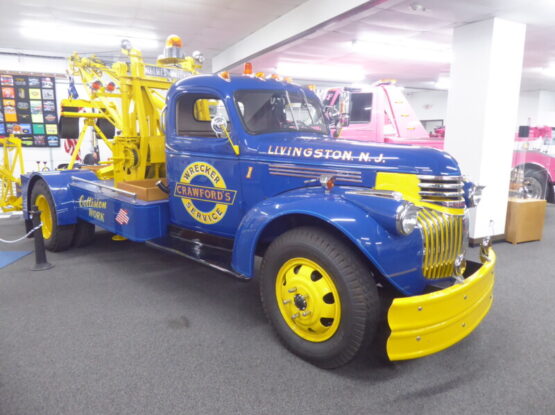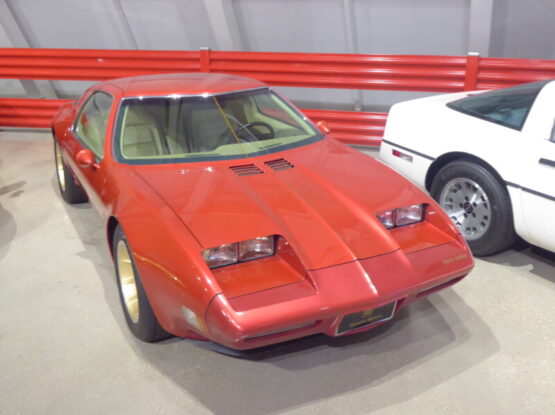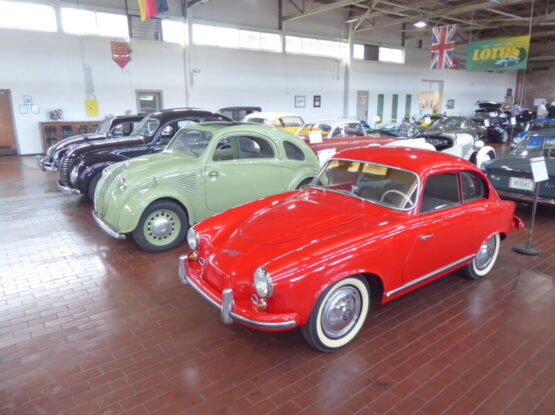Located about 75km north of Munich, the Bavarian town of Ingolstadt could be notable simply for its historic old buildings, which adjoin the banks of the Danube, and indeed until relatively recently that was probably its greatest claim to fame.



Nowadays, though it is home to Audi. If you come off the A9 autobahn north of the city, you soon see an enormous factory complex sprawled before you. It’s truly massive, as you find out when you have to drive round almost three sides of the site, to reach the Audi Forum area. Relatively recently opened, Audi have brought together a customer collection facility and a museum to show their heritage, in an imposing modern building. A nominal entry fee of €2 is charged for admission, and then three floors of display area await the visitor. The displays are not crammed together as can sometimes be the case in museums, but there are plenty of exhibits and lots of information about the Auto Union organisation that became known simply as Audi during the 1960s. There’s lots to see, and unlike its German competitors, probably little of the early stuff is familiar. Certainly it was not to me, and having made one visit where I took too few notes, I have now been back and done a better job.



You are encouraged to start your tour by taking an elevator to the third floor, and to work your way down to the ground, which is what I did. When you arrive at the top storey, you are able to look down and see some of the exhibits on the lower levels, and this is what first caught my eye:




 ROAD CARS
ROAD CARS
Founding father of Audi is a gentleman called August Horch. He started his involvement with the automotive sector when he took up a job at the fledgling Daimler-Benz organisation in Mannheim in 1896. It was not long before he decided to set up his own car company, which he did in 1899, in Cologne, using his own name. His first car appeared in 1901. This car, the oldest on show in the museum, dates from 1903 and is a 10-12PS model. A 2 cylinder model, it was relatively unusual for the period that it used shafts rather than chains to transfer drive power to the wheels. The tonneau body is also quite unusual, in that access to the rear seats is from the back of the car.

Horch was soon in trouble with the fellow directors of his company, and things came to a head in 1909, when he decided to leave and set up another company. As he was unable to use his own name, he selected the Latin equivalent, namely Audi. This is an example of the third model type produced by the new company, the 1913 14/35 PS Typ C Limousine. This car was produced until 1925, and scored notable success in motor sport events of the day, winning the Austrian Alpine Rally in 1912, 1913 and 1914.

During the 1920s, lots of relatively small and cheap cars appeared in every major car producing company, and this is one of them, the 1923 Wanderer 5/15 PS Typ W8 “Puppchen” (Little Doll). The cars got their nickname from a song in an operetta bu Jean Gilbert which premiered in Berlin 1912, as a Wanderer W3 was rolled onto the stage just as a singer began singing a song with the word “Puppchen”. Both the car and the song became a top hit, and it was produced for 14 years. Seating three, the passengers sat in tandem. This particular car spent most of its life in Australia.

By 1925, this was the only Horch in the range, the 10/35 Phaeton. This particular car was designed for show in Stockholm, and then for use by the Swedish Royal family as a “hunting car”

This is a 1927 Horch 8 Typ 303 Phaeton. First presented in the autumn of 1926, this car manifest the best example of German engine technology to date. The in-line eight-cylinder 3132cc engine with double overhead camshafts was designed by Paul Daimler, Gottlieb Daimler’s son. It generated 60 bhp which was enough to give the car a top speed of 100 km/h. Even the most basic version of this model, an open tourer, rated among the top luxury vehicles in Germany. An impressive 8.490 of these double-camshaft engines were built before production came to an end in 1931.

The 1923 Audi 8/22 Typ G Phaeton is an example of a relatively small and inexpensive car. First shown in 1914, this is believed to be the only example of the Type remaining.

This 1925 Audi 18/70 Typ M Pullman was one of the most expensive cars offered for sale in Germany. Launched in 1923, the model featured an all alloy engine


Successor to the Typ M was this, the Typ R, represented as a 1929 19/100 Typ R Imperator. This was the first Audi with an 8 cylinder engine, and with 100 bhp, it was a powerful car. The engine developed peak torque from 100 rpm, so it was very tractable and could be driven almost anywhere in top gear. The car cost less to make than the Typ M that it replaced, despite its far greater level of sophistication.

This is the first Wanderer built with left hand drive, a 1928 8/40 PS Typ W. It was modern for the day.


This 1932 DKW Front F1 was also modern, as it was the first volume car produced with front wheel drive. It was the cheapest car on the German market at the time. Launched in 1931, basic models had just 2 seats, and this is a rare example as a 4 seater and with a canvas body.



By the early 1930s, there were many manufacturers offering cars, but this fact and the onset of the economic crisis caused by the Great Depression meant that few were able to sell sufficient cars to be able to make a profit. Many simply ceased to exist, and it seemed as if the same could apply to Audi, DKW, Horch and Wanderer, but rather than forcing a winding up, the State Bank of Saxony who were the main creditor, in 1932, instigated the creation of the Auto Union which brought all 4 companies together into a single group. With 4100 employees, this made the Union the second largest car manufacturer in Germany, behind Opel. Once the Union was created, new possibilities emerged as what were separate companies were now in a position to share engineering and manufacturing plants.This 1934 Audi Typ UW took the letter W as an addition to the name in recognition of fact that it had a Wanderer based engine. The front wheel drive system was DKW based and the car was made at the Horch plant.






This 1936 DKW Schwebenklasse is an unusual car. Taking the streamlined styling that started to become popular in the mid 1930s, it sported a body built out of wood. The engine was a 1.1 litre 2 stroke V4. The name comes from its floating front axle, which was intended to stabilise the car when cornering. It also featured a four speed gearbox and a freewheel, which reduced fuel consumption and also reduced the spluttering typical of a 2 stroke engine when coasting.




Wanderer brought the Porsche designed 1.7 to 2.0 litre 6 cylinder engine to the Auto Union fold. First appearing in 1932 in the W15, the engine and chassis were gradually improved. This is a 1936 model W40 in which they were fitted.


The 1937 DKW F5 was sometimes called the “Little Horch”, as it was designed and built at the Horch plant.


A 1938 Wanderer W25K Roadster. This was a fast car by the standards of the day, fitted with a 2 litre 6 cylinder supercharged engine, designed by one Ferdinand Porsche, which developed 85 bhp, more than twice the output of the W50 model, which also dated from the same time..


This 1939 Audi 920 Limousine reverted to rear wheel drive, as the technology did not exist to allow the power developed by its 75 bhp 6 cylinder overhead cam engine to be reliably transmitted to the front wheels. This was a huge quality car, and was expensive. This particular model was owned by the same family from new until 1998.



Audi did not offer the most expensive cars in the Union, though. That honour went to Horch, who produced small quantities of superlatively excellent cars, sold at high prices. Three examples were on show in the museum. The yellow car is a 1932 670 Sport Cabrio, which featured a 6 litre V12 engine. Only 58 such cabrios were made, along with 20 Pullman saloons.




Later in the decade, the range had been simplified, with 830 based models sporting an 8 cylinder 3.0 engine and 850 cars with a 5 litre V8. The green car is a 1937 853 Sport Cabrio and comes with a precursor to metallic paint, called “fish silver”.



The black Horch is a 1939 855. It cost 22,000 Reichmarks when new, which was a lot of money, and only 7 were made.


This 1941 Horch 901 Typ 40 was based on a mid-sized all terrain passenger car that first appeared at the 1936 Berlin show. Modified for use it became a staple of the armed forces, and between 1940 and 1942, 15.169 examples were produced.

The last civilian vehicles were produced in 1941, and then in 1942, production ceased altogether.

The Russians took control of everything that remained at the end of the War, and pulled down all the existing production facilities soon after. They then liquidated the Auto Union AG in 1948. However, all was not completely dead, and it did not take long before the former company was producing cars again. The first vehicles were DKWs, though one Horch was also made. This is the 1953 Horch 830 BL, and it was built as a one-off for Dr Bruhn, was the Chief Engineer of the company. The car was sold to an US soldier in 1956 who took it to Texas, and it spent 50 years slowly deteriorating in the desert there, before its recent discovery and return to Germany.


This 1950 DKW F89L Schnellaster is typical of the postwar product, and was the first vehicle made in Ingolstadt. Front wheel drive, with a 2 cylinder 2 stroke engine, it met the needs of the recovering German trader and 11.500 had been sold within a year. This particular example was in service until 1977.






Family cars were based on pre-war designs, but suitably updated, and this 1951 Meisterklasse F89P was the result. 59,000 of these cars were made.





The cars were continually updated in the 1950s, and by 1953 the name 3=6 Sonderklasse had been adopted. Three cylinder two strokes were somewhat ambitiously touted as being as smooth as a 6 cylinder motor. This F91 Cabrio is one of 432 open topped cars built by Karmann, and was the object of some desire by all in the 1950s.





The 1955 3=6 Sonderklasse Limousine was more representative of the cars that ordinary Germans bought. These cars were tough and an example won the 1954 European Rally Championship.





By the mid 1950s, Auto Union was struggling, as they were still producing relatively small volumes of cars, whereas main rivals Volkswagen and Opel had ramped up their production volumes significantly. In 1958, the motorcycle business, which once had been strong, but which had come under massive pressure from the increase in popularity of microcars, was sold off. There were plenty of examples of the motor cycles in the museum.




In 1957, it was decided to use the name of the parent company and so cars appeared badged Auto Union. Based heavily on the Sonderklasse, the 1000 model featured a larger engine, now a heady 1000cc. Still a 2 stroke design, the standard car generated 44 bhp, and the faster 1000S car which appeared in 1961 mustered 50 bhp.







Mercedes-Benz bought an interest in the Auto Union in 1958, seeing their small and cheap cars as an ideal complement to their more costly products. This did provide the necessary funds to help to launch a brand new design which appeared in 1959, the DKW Junior. This front wheel drive car still sported the 2 stroke 3 cylinder engine, but brought other advances such as the use of all round torsion bar suspension.






The venture to produce small sports cars in the style of the Ford Thunderbird was not a success, though. this 1965 1000 SP Roadster is one of just 1440 roadsters and 5000 coupes that were built over a 6 year period.






In 1964, a new car appeared to replace the old Auto Union 1000S, the DKW F102. Still endowed with a two stroke engine, it did at least feature unitary body construction.







At the end of 1964, it became clear that Mercedes-Benz were not interested in this company any more, and they sold out to Volkswagen who took a controlling interest. The first new car appeared in 1965. the Audi. Initially it was called just that, but soon it gained the designation 72. This successor to the DKW F102 was the first car with a 4 stroke engine. With 72 bhp from its 1.7 litre engine, and lightweight body, it performed well, and set the scene for what was to come.




The real breakthrough came with the 1968 launch of the 100. Front wheel drive and light weight meant that even with an engine smaller than class average, this car performed well. It sold strongly, with 827.424 cars made in its 8 year production life.



In 1967, rival NSU had launched a car targetted at the same sort of the market, the rotary powered Ro80. Sadly, durability issues with the revolutionary Wankel engine meant that NSU looked set for oblivion, as they needed money for warranty claims as well as to try to develop new product to replace the venerable Prinz based small cars. Audi bought up NSU, and gradually incorporated them into their operations, with the last NSU badged car being produced in 1977. The plant at Neckarsulm lives on, and these days builds A6s and A8s, as well as hosting an advanced technology centre which undertook much pioneering work on the TDi engine.











The first million selling model was the B1 model Audi 80, which was launched in 1972. This car shared its underpinnings with the VW Passat, and proved very popular for those who wanted a well finished medium sized car, even if in 1.3 litre LS guise, as this car is, it now appears ever so basic.




Next up was a small car, the Audi 50. This model was launched some months before the far better known Polo, but it was never exported to the UK, for instance and production ceased in 1978.








The second generation 80 appeared in 1978 and was again a huge hit for Audi. This cutaway is of the GLE version.



Audi’s real tour de force came in 1980 when the Quattro was launched. This development, of permanent four wheel drive, was based on work undertaken in 1976 for a German military contract that led to the Iltis. Initially, Audi thought they might sell 400 of the road going car, which would suffice to allow them to homologate the rally car which was their real intent. Nearly 11,500 cars were actually sold, and then the quattro concept was applied to all other models in the Audi range. It was the defining moment for the brand, without question. The later Sport model was produced again to help homologate a shorter wheelbase rally car. Just 214 were produced and this is the very first one.













Not that Quattro was the sole innovation as the third generation 100 model proved when it was launched in late 1982. This car had the lowest drag coefficient of any production car at the time, of just 0.30cd for the base models, which made it performant and quiet.





As cars have become ever heavier, so the need to find new ways of maintaining strength and yet to reduce undesirable weight have become a challenge for all. Audi undertook some pioneering work in this area, with their Aluminium Space Frame, which they first showed in 1993, as a precursor to using it in their new luxury car, the A8. It weighs 100 – 15kg less than the equivalent steel frame. Having shown the frame at the 1993 Frankfurt Show, they then showed a car clothing it, using a W12 4.8 litre engine, at the 1993 Tokyo Show, and this is it.


 MOTOR SPORT
MOTOR SPORT
Audi have a long and successful career in motorsport, all the way back to the Austrian Rally winning days of the Typ C. It was in the 1930s when they really came to prominence, though, with the famous “Silver Arrows”. These cars won 40 races and established 38 land speed records. They were all taken the Russians as reparations for the second world war, though, so the fate of some of them is unknown. This 1939 Typ C/D hillclimber is a combination of the 16 cylinder engine from the Typ C and the chassis of the Typ D.




The Streamlined Racer made its debut in the 1937 Avus race. Later it was driven by Bernd Rosemeyer on the new Autobahn from Darmstadt to Frankfurt at over 400 km/h. This is a reproduction of that 16 cylinder 560 bhp car.




This 80 took part in the 1980 European Touring Car Championship and won the title with Peter Seikerl driving it.


A 1983 model Audi Quattro, as driven by Michele Mouton, a car in which she came second in the 1982 World Rally Championship.






A 1989 90 quattro IMSA-GT. Driven by Hans-Joachim Stueck, this car won 7 races, and would have won the title had the car competed in the 2 long distances races of the series.



This V8 DTM car competed in the 1990 German Touring Car championship, again driven by Stueck, and won the title in the car’s first season. Frank Biela then defended it successfully in 1991.




Audi first appeared at Le Mans in 1999, and boasts an impressive results sheet ever since. These cars are the R8R models from the 1999 and 2000 campaigns.



 CONCEPT CARS
CONCEPT CARS
One of the most imaginative parts of the museum display was this collection of rotating display plates, on which many of the concept cars from the recent past were shown. It takes about 20 minutes for the whole display to complete a whole revolution.






 1955 DKW STM Prototyp “Kunstoff” (plastic)
1955 DKW STM Prototyp “Kunstoff” (plastic) Audi RS2 – the Avant version is well known, this is the only saloon that was produced.
Audi RS2 – the Avant version is well known, this is the only saloon that was produced. Quattro Spyder – one of my favourites
Quattro Spyder – one of my favourites


 ASF
ASF


 TT Coupe
TT Coupe

 TT Roadster
TT Roadster
 A2
A2

 Steppenwolf
Steppenwolf



 Pikes Peak
Pikes Peak


 TT Shooting Brake
TT Shooting Brake




 Le Mans
Le Mans


 Roadjet
Roadjet

 RSQ
RSQ



 Rosemeyer
Rosemeyer


 Avus
Avus
 TEMPORARY EXHIBITIONS
TEMPORARY EXHIBITIONS
The ground floor of the museum is the area that contains a temporary or special exhibition. When I visited in June 2008, there were a number of cars associated with heads of state from around the world. The idea was to show how Audi products had been selected by some, but not all, so there were some notable non Audis, which are pretty obvious! In August 2010, the area was under construction for a motor-cycle related display that will be completed shortly

















This is definitely a museum worth seeing should you be in the area. There is a good cafe/restaurant on site, and a small showroom area, as well. Only 75km north of Munich, it makes for a good day out.












































































































































































































































































